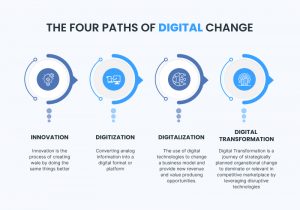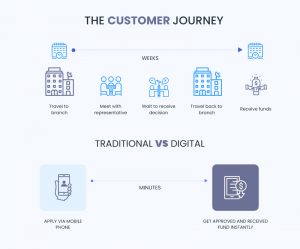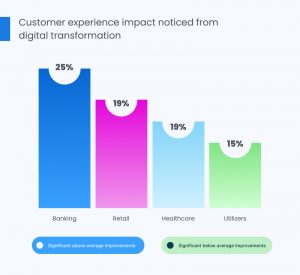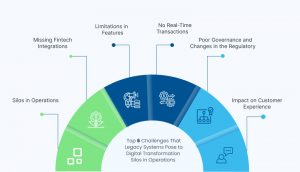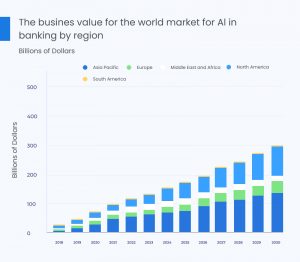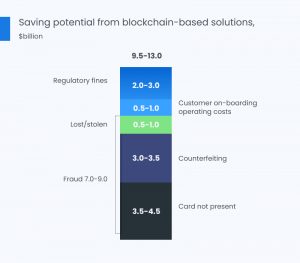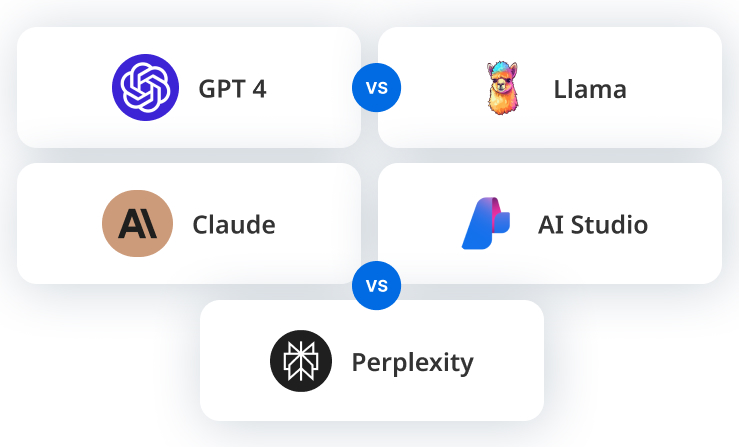“At least 40% of all businesses will die in the next 10 years… if they don’t figure out how to change their entire company to accommodate new technologies.” — John Chambers, Cisco
The banking sector is under pressure as consumers shift spending to tap into new technological frontiers. This has led to a growing demand for digital transformation in banking.
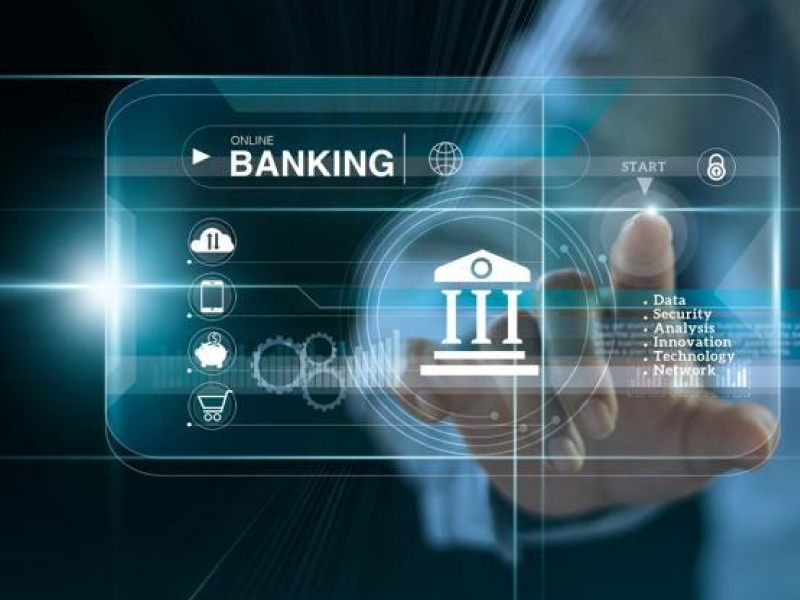
Banks scramble to keep up with the competition; hence, many turn to digital transformation initiatives to future-proof their businesses. However, digital transformation is not without its challenges. Banks must overcome several hurdles to ensure the successful adoption and implementation of digital transformation projects.
Today, in this blog, we will explore the challenges and opportunities associated with digital transformation in banking. So, let us get started without any further ado.
Table of Contents
What is Digital Transformation?
Digital transformation is the integration of digital technology into all business areas, resulting in fundamental changes to how businesses operate and deliver value to customers.
It is a wholesale transformation of an organization that touches every aspect of the business, from culture and structure to processes and products.
Many technological advances facilitate digital transformation, including the proliferation of smart devices, the rise of the Internet of Things, and the advent of artificial intelligence and machine learning. These technologies empower businesses to collect and analyze data at an unprecedented scale, opening new opportunities for insights and innovation.
However, digital transformation is not just about technology. It is also about changing how businesses operate, making them more agile, customer-centric, and data-driven. To be successful, digital transformation initiatives must be driven by a clear strategic vision and supported by comprehensive organizational change management.
The Transition From Conventional to Digital Banking
The banking sector has been slower than other industries to digitize, but the tide is beginning to turn. Banks are all set to adopt new digital technologies or risk being left behind by nimbler fintech startups. In response, banks are making significant investments in digital transformation.
What is Driving Digital Transformation in Banking?
Several factors are driving the demand for digital transformation in banking.
- Increasing Demand of Customers- The first is the changing needs of customers. Banks are under pressure to meet the expectations of digital-native customers who have grown accustomed to the convenience and user-friendly experience of online shopping and social media.
- The Emergence of New Technologies– In
addition, new technologies are creating opportunities for banks to reach new markets and tap into new customer segments. For example, the rise of mobile commerce is enabling banks to offer location-based services and contextual experiences tailored to customers’ needs in specific situations. - The Increased Competition: The banking sector is also facing increased competition from new entrants, such as fintech startups and big tech firms. These companies are using technology to offer innovative products and services that are shaking up the status quo.
- The Impact of Regulations: Finally, banks are feeling the impact of stricter regulations, particularly around data privacy. The introduction of GDPR in the European Union and the CCPA in California are just two examples of how regulations are becoming more stringent.
- The Need for Cost Cutting: Banks are under pressure to improve their profitability in the current environment. One way to do this is to reduce costs. Digital transformation can help banks achieve this by automating manual processes, reducing headcount, and improving operational efficiency.
Digital transformation can help banks achieve these goals by automating manual processes, improving customer self-service, and reducing operational costs.
Also Read: RPA in Banking: Benefits, Use-Cases, and Steps to Deploy
What Are the Benefits of Digital Transformation in Banking?
Benefit 1: Improved Customer Experience
One of the most important benefits of digital transformation is improved customer experience. Customers expect instant gratification and 24/7 access to their banking services in today’s world. They also demand personalized service and want to be able to bank on their terms.
With digital transformation, banks can provide an exceptional customer experience by offering self-service channels, such as online and mobile banking, as well as personalized advice and service.
Benefit 2: Enhanced Operational Efficiency
Another key benefit of digital transformation is enhanced operational efficiency. Technology can help banks automate manual processes, reducing errors and saving time. It can also help banks better use data and analytics to drive decision-making.
Benefit 3: Increased Revenue Opportunities
Digital transformation can also lead to increased revenue opportunities for banks. Banks can identify new areas for growth and new products and services to offer their customers by using data and analytics. They can also use technology to upsell and cross-sell existing products and services.
Benefit 4: Improved Risk Management
Risk management is another key area where digital transformation can benefit banks. Traditional risk management strategies are no longer effective with the massive volume of data generated by customers, transactions, and other interactions.
Digital transformation can help banks make better use of data and analytics to identify and manage risk more effectively. By harnessing the power of technology, banks can stay one step ahead of their risks.
Benefit 5: Greater Agility
Another significant benefit of digital transformation is greater agility. In the past, banks have been slow to respond to changes in the market. However, with digital technologies, banks can be much more agile, quickly adapting to changes in the market and customer needs.
Benefit 6: Improved Compliance
Digital transformation can also help banks improve their compliance. By automating manual processes and using data and analytics, banks can reduce the risk of human error and ensure that they meet all regulatory requirements.
Benefit 7: Increased Competitive Advantage
Finally, digital transformation can help banks increase their competitive advantage. Banks can gain a significant edge over their competitors by using technology to improve customer experience, operational efficiency, and risk management.
What are the Challenges of Digital Transformation in Banking?
Banks face numerous challenges when it comes to digital transformation.
- First, there is the challenge of legacy systems. Many banks rely on outdated technology infrastructure that is not compatible with new digital technologies. This can make it challenging to integrate new technologies and lead to data silos that impede the flow of information between departments.
- Second, banks must overcome resistance to change from employees. Many banking employees are hesitant to embrace new digital technologies, fearing that they will make their jobs obsolete. This resistance can lead to disruptions and delays in implementing digital transformation initiatives.
- Third, banks must grapple with the challenge of data security. As more data is collected and shared digitally, data breaches and cyber-attacks increase. This is a primary concern for banks, which must take measures to protect customer data while also complying with stringent regulations.
- Finally, banks must manage the expectations of shareholders and other stakeholders. Digital transformation can be costly and time-consuming, and there is no guarantee of success.
This can lead to pressure from shareholders to generate quick results, putting pressure on management and leading to unrealistic expectations.
How to Successfully Execute a Digital Transformation Initiative?
Despite the challenges, there are many steps that banks can take to ensure the successful execution of a digital transformation initiative.
- Define the goals and objectives of the initiative.
- Assemble a team of experts to lead the initiative.
- Conduct a comprehensive analysis of the current state of the bank.
- Develop a realistic plan for the implementation of new technologies.
- Secure buy-in from employees and other stakeholders.
- Create a governance structure to manage the initiative.
- Make the necessary investments in new technologies.
- Monitor progress and adapt the plan as needed.
Following these steps will not guarantee success, but they will give banks a better chance of successfully executing a digital transformation initiative.
Top Digital Transformation Technologies for Banks
-
Artificial intelligence (AI)
Banks deploy AI for various tasks, including fraud detection, customer service, and marketing. For example, AI can identify patterns in customer behavior that may indicate fraudulent activity.
Besides, AI can provide customer support by answering questions or providing recommendations. And AI-powered chatbots can be used to engage with customers personally, providing them with tailored content and offers.
Read Also: Artificial Intelligence(AI) In Banking: Reforming The Customer Experience
-
Big Data and Analytics
Banks are sitting on a goldmine of data, including transaction, customer, and market data. But this data is only valuable if it can be harnessed and used. That’s where big data and analytics come in. By analyzing this data, banks can gain insights into customer behavior, identify trends, and make better decisions about products, services, and strategies.
-
The Internet of Things (IoT)
The IoT refers to the growing network of physical devices connected to the internet. These devices can include everything from cars and home appliances to wearable devices and industrial equipment. Banks use the IoT to track customer behavior and provide new services such as location-based notifications and offers.
-
Blockchain
Blockchain is a distributed database that allows for secure, transparent, and tamper-proof transactions. It is the technology that powers digital currencies like Bitcoin. Banks use Blockchain to streamline back-office processes, such as KYC (know your customer) and AML (anti-money laundering). With Blockchain, banks can create new financial products, such as smart contracts.
-
Cloud Computing
Cloud computing is a way of delivering IT services over the internet. Banks are using cloud-based solutions to reduce costs and increase agility. Cloud services can be used for various applications, including storage, backup, disaster recovery, and analytics.
-
Digital Currencies
Digital currencies are created and managed using blockchain technology. They are decentralized, meaning they are not subject to government regulation. Bitcoin is the best-known digital currency, but there are many others, such as Ethereum, Litecoin, and Zcash.
-
Mobile Payments
Banks are using mobile payments to make it easier for customers to send and receive money. Mobile payments refer to payments made using a mobile device, such as a smartphone or tablet. Mobile payments can be made in person, online, or by phone.
Digital Transformation Trends for Banks
In addition to the technologies we’ve just described, a few digital transformation trends are worth mentioning. These include:
1. Open Banking
Open banking is a term used to describe the trend of banks opening up their data and APIs to third-party developers. This enables fintech and other companies to build new applications and services on top of existing bank infrastructure. Traditional banks often see open banking as a threat, but it also presents an opportunity to partner with fintech and tap into new markets.
2. APIs
An API (application programming interface) is a set of rules that enables two pieces of software to communicate with each other. Banks use APIs to provide access to their data and services to third-party developers. This allows fintech and other companies to build new applications and services on top of existing bank infrastructure.
3. Microservices
Microservices are a software architecture that enables developers to build applications as a collection of small, independent services. This approach is well-suited to cloud-based deployments and is becoming increasingly popular in the banking sector.
4. DevOps
DevOps is a set of practices that enables developers and operations teams to work together more effectively. It helps to automate and improve the process of software delivery. DevOps is becoming increasingly popular in the banking sector as banks look to increase their agility.
5. Chatbots and Virtual Assistants
Chatbots are computer programs that simulate human conversation. They are commonly used to provide customer support and assist with sales and marketing tasks.
Virtual assistants are similar to chatbots, but they are powered by artificial intelligence (AI) and can understand natural language. Banks use chatbots and virtual assistants to provide better customer service and reduce costs.
6. Augmented Reality (AR) and Virtual Reality (VR)
Augmented reality (AR) is a technology that superimposes computer-generated images in the real world. Virtual reality (VR) is a technology that creates a simulated environment. Banks are using AR and VR to provide better customer service and support.
7. Wearables
Wearables are devices that can be worn on the body, such as smartwatches and fitness trackers. Banks are using wearables to provide better customer service and support. For example, banks use smartwatches to allow customers to make payments and access their accounts.
8. 5G
5G is the next generation of mobile phone networks. It offers faster speeds and lower latency than existing 4G networks. Banks are using 5G to provide better customer service and support. For example, banks use 5G to allow customers to make payments and access their accounts.
9. Edge Computing
Edge computing is a type of distributed computing that brings computation and data storage closer to the network’s edge. It is well-suited to applications that require low latency, such as real-time analytics. Banks are using edge computing to provide better customer service and support.
Future of Digital Transformation in Banking
The banking industry is currently in the midst of a digital transformation. Increasing regulation, competition from new entrants, and disruptive technologies have contributed to a challenging operating environment.
In response to these challenges, many banks are undertaking digital transformations. This involves using technology to radically improve how they operate, becoming more agile, efficient, and customer-centric. When done correctly, digital transformation can help banks not only survive but thrive in the new world order.
In the upcoming years, we can expect to see even more widespread adoption of digital transformation in banking. This will be driven by many factors, including the continued growth of fintech, the increasing importance of big data and analytics, and the need to meet customers’ evolving demands.
Read Also: Digital Transformation in Manufacturing- A New Wave for the Industry [Benefits and Trends]
Conclusion
Digital transformation in banking is inevitable. Banks must embrace new technologies to remain competitive. The technologies and trends we’ve described are just a few of the most important ones to keep an eye on.
Digital transformation will enable banks to provide better customer service, reduce costs, and increase agility.
Banks can take the help of digital transformation service companies to make a roadmap for their digital transformation journey. It is important to partner with a company with extensive experience in the banking sector and that understands the unique challenges banks face.
FAQs
1. What are the 4 main areas of digital transformation?
There is no one-size-fits-all answer to this question, as the 4 main areas of digital transformation will vary depending on the specific business and industry. However, in general, these 4 main areas can be classified as follows:
- Customer experience
- Employee experience
- Operational process improvement
- Business model innovation
2. What are the benefits of digital transformation?
There are many potential benefits of digital transformation, including anything from improved customer experiences and engagement to more efficient operations and processes. In general, businesses can expect to see increased productivity, efficiency, and growth due to digitizing their operations.
3. Why is digital migration necessary in banking?
There are several reasons why digital migration is essential in banking. First and foremost, it allows banks to keep up with the ever-changing technology landscape. By digitizing their operations, banks can stay ahead of the curve and remain competitive in an increasingly digital world.
Additionally, digital migration can help banks improve their customer service and engagement, as well as their overall efficiency and productivity. Finally, digital migration can also help banks reduce the costs associated with traditional banking operations.
4. What are the drivers of the digital banking transformation?
There are many drivers of the digital banking transformation. First and foremost, customers increasingly demand more convenient and user-friendly digital experiences from their banks. In response, banks must digitize their operations to meet these customer expectations.
Additionally, the ever-changing landscape of technology is another driver of the digital banking transformation. As new technologies emerge, banks must adapt to stay ahead of the curve and remain competitive. Finally, the increasing costs associated with traditional banking operations are another driver pushing banks towards digital transformation.
5. What are the new trends in digital banking?
There are many new trends in digital banking. First and foremost, banks are increasingly focusing on customer experience and engagement. To meet the demands of today’s digital customers, banks are working to create more user-friendly and convenient online experiences.
Artificial intelligence (AI) is becoming an essential part of digital banking, as banks look to use AI to improve customer service and fraud detection. Finally, big data is another new trend in digital banking, as banks seek to mine customer data to better understand their needs and preferences.
6. What is the difference between digital transformation and digitization?
There is a difference between digital transformation and digitization. Digitization is the process of converting information or data into a digital format. Digital transformation, on the other hand, refers to the broader process of using digital technologies to improve business processes and operations.
In other words, digital transformation goes beyond simply digitizing information; it also includes using digital technologies to improve how businesses work.

